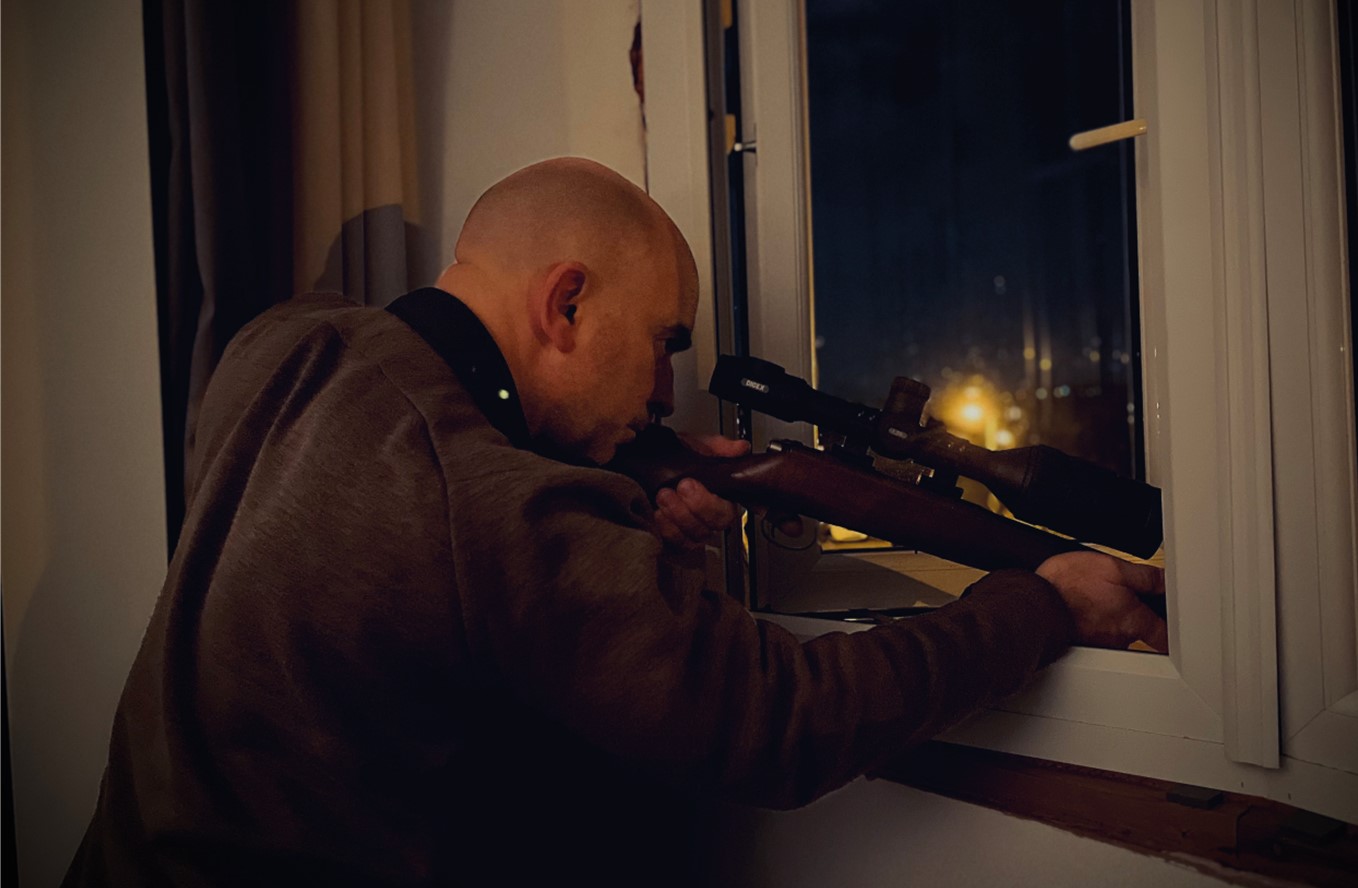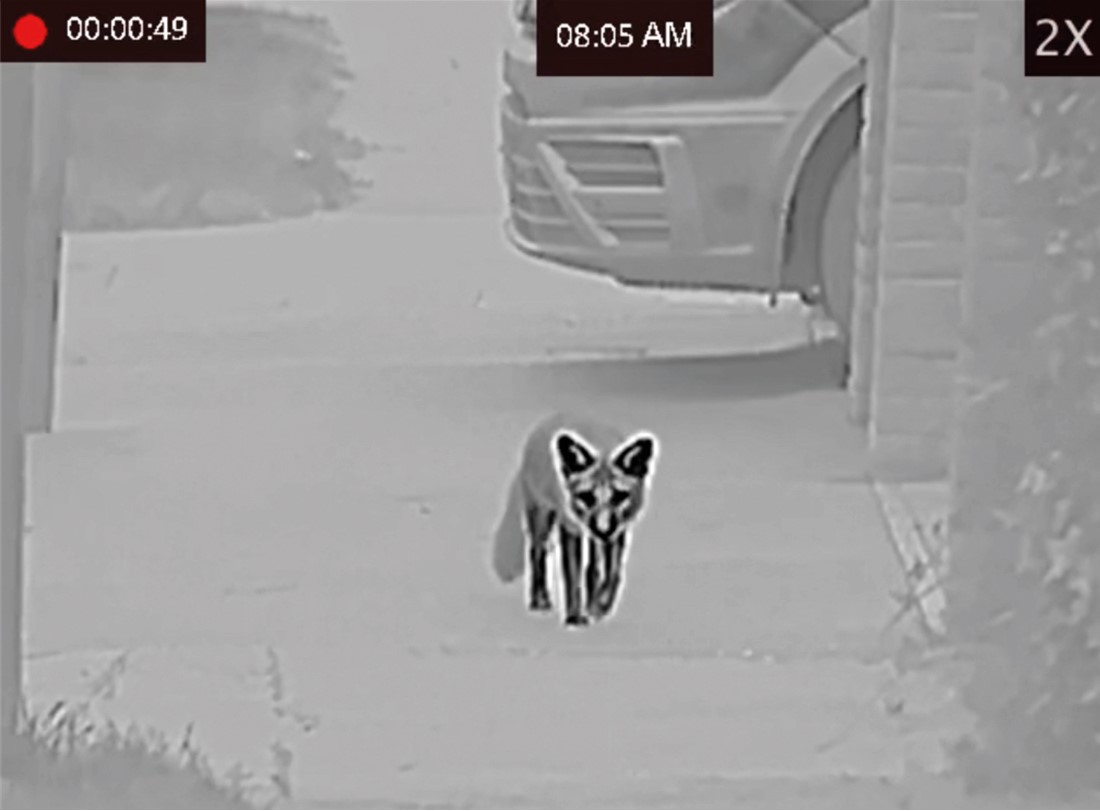Another 15 minutes had passed, so I allowed myself another penny sweet as a little reward for my patience. It’s a good way of mentally dealing with long waits when ambushing foxes, especially in the cold, and something I learned to do as an apprentice plumber during one winter spent in the snow footing a ladder on a guttering contract.
The frost sparkled on the balcony in the moonlight and my breath hung in the cold, still air. This was the third night I had sat here, tucked behind the low parapet wall, my frozen fingers clutching my .22 rifle, occasionally peering over the wall to check with the thermal spotter for a visitor.
 The long wait ends and it’s finally the moment of truth!
The long wait ends and it’s finally the moment of truth!
Urban fox control jobs can be quite boring, with little more than an empty garden to look at. And being in the vicinity of your intended quarry requires you to keep noise and movement to an absolute minimum.
My midnight cut off was rapidly approaching and I’d already resigned myself to the fact that this wary fox wasn’t going to put in an appearance. My flask held just enough coffee for one last refill, and in a well-practised manoeuvre I slowly and quietly emptied the contents into the cup.
Setting it aside I again checked the garden with the thermal – and there he was, not 15yd from me and standing peering suspiciously up towards the balcony, halfway between the fence and the bait site. I dared not move for fear of him doubling back over the fence. After a few seconds he decided all was well and trotted confidently over to the sandbags where I’d spread out the cat food.
 Urban foxes are notoriously tricky to dispatch
Urban foxes are notoriously tricky to dispatch
The home owner had been steadily putting the bait out in the same spot over the past couple of weeks and the fox had regularly been coming for dinner. Giving him a moment to start feeding, I eased the rifle silently up onto the wall and smothered the safety catch with my fingers to deaden the soft click. The sound was barely audible to me but the fox instantly swung his head round to stare at the balcony again for a few seconds before resuming its meal.
I lined the fox up in the scope and, placing the crosshairs between its eye and ear, squeezed the trigger. With a dull pop followed by a thwack on impact, it’s legs buckled under it and its chin dropped onto the sandbag before it rolled to the ground, blood trickling from its ear. I breathed a sigh of relief – not so much that I’d got the fox, but more that I’d done so safely and humanely without the fox disappearing injured into a neighbour’s garden.
This particular job had concerned me somewhat as the home owner had insisted on shooting the fox rather than trapping it, wanting it gone as quickly as possible as it had attacked her small, elderly dog, and she herself was rather frightened of it. The problem was that from the balcony to the end of the garden was a mere 15yd and beyond the timber fence at the end was a neighbouring house with it’s patio doors, not 5yd further on.
With safety my main concern, I’d stacked a dozen sandbags against a sheet of 18mm ply leaning against a tree by the fence. I knew from some close-range testing that a single bag of sand was sufficient to stop a subsonic bullet, so as long as the fox was up against the bags the bullet wouldn’t go any further.
Over the years I’ve found myself shooting urban foxes in all kinds of locations and tend to use much the same method, generally with the little .22 rimfire. It’s important to mention here that shooting in such an environment requires you to have an ‘open ticket’. In other words, there are no conditions on your licence stating you can only use your firearm in a certain location.
Ultimately it’s for you to decide that the shot is safe and be responsible for your actions. Naturally some form of shooting insurance is also highly advisable and something we all should have in any case.
The .22 is a brilliant little round, but it’s also a double-edged sword. It has the benefit of being quiet and effective, but with the downside of being extremely prone to ricochets off almost any surface.
The likelihood is that at close range, once the bullet has done its job on the fox it will retain enough energy to continue through the animal and still have the potential to cause serious damage, so will always require a solid backstop. One also needs to consider the possibility that even at short range, one can still miss the target. Foxes are flighty animals and always on the move, so a sudden turn of the head and a poorly timed shot can result in the round zipping cleanly past the target.
In these situations a good option is to use segmented rounds, whose bullets are designed to break into several sections on impact, causing more internal damage and helping reduce ricochet. Bullet placement is also critical to inflict an instant and humane demise, after all, the last thing you want is an injured fox escaping into a neighbour’s garden.
To achieve a clean kill on a fox with a .22 I will always head-shoot them, with my preferred shot being placed from the side between the eye and the ear. The back of the head, directly between the eyes or straight through the top of the head when shooting down are also good alternatives. Shooting down towards the ground will also help to achieve a much safer shot, so the use of an upstairs window, balcony or flat roof will always be the number-one option, or perhaps the use of a portable highseat if the situation dictates.
 Mark’s meticulous forward planning finally paid dividends
Mark’s meticulous forward planning finally paid dividends
Another thing that I will always do on my initial survey of the area, once I’ve decided on my firing point and the bait site, is to use a small pocket rangefinder to take the range at which I will be shooting, as well as get an idea of the angle. I will then zero the rifle from a highseat on the farm, to replicate as closely as possible the shot that I’m likely to take, to ensure I can place a shot perfectly on target without having to aim off.
Very often the tricky part of these jobs is getting the fox in just the right place for the shot and at the right angle.
When setting up the sandbags I usually stack several up flat to form a sort of wall that will act as the main backstop. I then lay one or two more out at a right angle estimated population of urban foxes in the UK is 150,000, increasing from roughly 33,000 in the 1990s from those pointing towards me. This will act as the table on which the bait will be left. The idea is that the shot will be taken as the fox leans over to take the bait from the side.
I like to also place an object at the end of the table, such as a flowerpot, to prevent the fox feeding on the bait with its back to me rather than from the side.
To give a little more time for a shot, it’s a good idea to use a bait that the fox can’t just pick up and move away with, which they seem to prefer to do, such as wet cat food. They will usually take their time lapping it up, and another advantage is that it usually comes in various smelly flavours that help draw the fox in.
It’s important that the bait is placed out after dark each evening so that it isn’t hoovered up by birds, and also that it’s done every night without fail around the same time.
A trailcam can be a big advantage here, as it will not only tell you how many foxes are feeding at the bait site, but also at what time. If there’s a regular pattern it can save some long hours of needless waiting.
I generally use a Nightvision scope rather than thermal for urban fox control, as they seem to be less perturbed by infrared lights. This is possibly due to numerous security cameras or other small lights that they no doubt see regularly around houses. The other reason is to positively identify the fox as a fox. Although this shouldn’t be a problem at such close ranges, it’s better to be safe than sorry. You certainly don’t want to shoot the neighbour’s cat!
 A flat roof can often be a foxer’s friend in urban situations
A flat roof can often be a foxer’s friend in urban situations